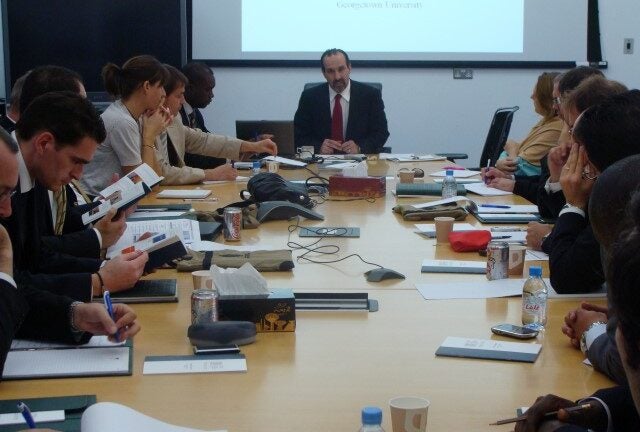CIRS Faculty Lectures, Dialogue Series, Distingushed Lectures, Race & Society, Regional Studies
Mehran Kamrava Lectures to HEC School of Management, Paris

Mehran Kamrava, CIRS Director and Interim Dean of the Georgetown University School of Foreign Service in Qatar, lectured to a group of French scholars from the HEC on the Geopolitics of the Gulf. Kamrava gave a broad overview of the relationships between the Gulf states and how these associations are shaped by the geopolitics of the region.
Through a series of topographic and geopolitical maps, Kamrava looked at how the Gulf region has progressed into a series of nation states in the post-Ottoman period. Many of these countries were voluntarily under the tutelage of British protection as a means to safeguard their interests against Iran. He argued that the Gulf states gained their independence at various periods in the twentieth century, the oldest being the Kingdom of Saudi Arabia, which was established in the 1930s. The UAE, Qatar, and Bahrain all gained their independence in the 1970s, after Britain vacated the areas east of the Suez Canal.
View the presentation from lecture below:
Geopolitics of the Gulf from Georgetown University School of Foreign Service in Qatar
As such, most of the Gulf states came into existence relatively recently, although the tribes and peoples that inhabit these areas are ancient groupings who have lived for centuries in sporadic fishing and pearling villages. In the past, there were no major urban centers but merely villages where wealthy families were later to emerge as the merchant classes and became the rulers of their regions. Kamrava maintained that “the national youth of these countries has significant consequences regarding economic development, the patterns of state-society relationships, and how political leaders assert their rule over their societies and the kinds of vision that they are able to articulate. These are recent political entities with very recent political histories.”
By the 1950s, the Gulf states become tremendously resource-wealthy, with an abundance of exploitable natural resources. Therefore, Kamrava argued, rentierism, or “the rent and the interest that they accrued from the sale of oil, become their economic mainstay.” As such, “the state-building in these countries is consistent with economic penetration of the West. If you look at the modern map of the region, particularly in places like Saudi Arabia, you see that state-building is simultaneous with massive amounts of wealth being pumped into the economy.”
In terms of existing boundaries, there are still several border disputes between many of the Gulf states. One major dispute, Kamrava noted, exists between Kuwait, Iraq, and Saudi Arabia. Although in recent years these border disputes have not erupted into open warfare, this was precisely the reason for Iraq’s invasion of Kuwait in 1990.
Turning to economic issues, Kamrava called attention to the increasing projected demand for oil in the coming decades, with the estimated 21.7 million bbl/d (barrels a day) that was being produced in the Gulf region in 2000 rising to 30.7 million bbl/d by 2010 and 42.9 million bbl/d by 2020. The Gulf’s share of world production is estimated to rise from 28 percent in 2000 to 35 percent in 2020. Not surprisingly, with very small population sizes, in recent decades, the Gulf states have registered some of the highest GNP & GDP average annual growth rates in the world.
Massive economic wealth has not made these states immune to the global economic downturn. In fact, according to Kamrava, the GCC state’s exposure to the global financial crisis has hit six areas particularly hard:
- Direct banking sector exposure to toxic assets;
- Sudden stop/reversal in foreign capital inflows;
- Weaker non-commodity export growth;
- Plunge in commodity prices, most notably crude oil; and,
- Faltering demand for energy-intensive industrial and building materials.
Kamrava noted that there has been a 60 percent fall in GCC hydrocarbons revenue in 2009, to around $200 billion. This, he argued, has had five notable consequences. It has, first and foremost, led to a sharp decline in liquidity and assets that fueled the 2002-2009 business growth spurt. Second, there has been a steady growth deceleration in all economic sectors. Third, there has also been a steady decline in inflation, especially in real estate and other consumer indices, leading to a fourth consequence, namely a wave of consolidation across several sectors, particularly among small and medium-size enterprises. Fifth and last, built-in structural resilience and growth momentum will make Qatar less susceptible to downturn, followed by Abu Dhabi, and Saudi Arabia.
Summary by Suzi Mirgani. Suzi is CIRS Publications Coordinator.